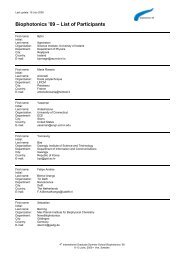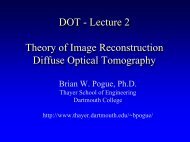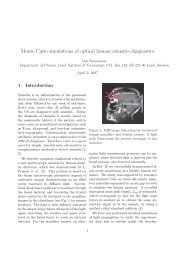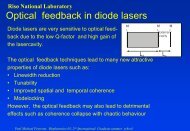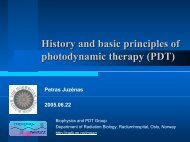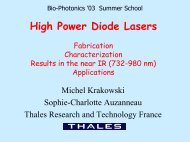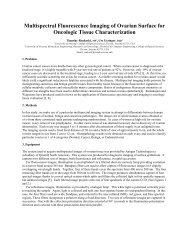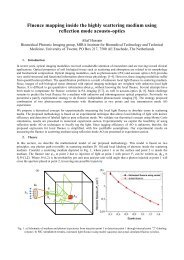Lasers and photothermal therapy
Lasers and photothermal therapy
Lasers and photothermal therapy
You also want an ePaper? Increase the reach of your titles
YUMPU automatically turns print PDFs into web optimized ePapers that Google loves.
<strong>Lasers</strong> <strong>and</strong> Photothermal Therapy<br />
Petras Juzėnas<br />
2005.06.22<br />
Biophysics <strong>and</strong> PDT Group<br />
Department of Radiation Biology, Radiumhospital, Oslo, Norway<br />
http://radium.no/moan
A laser is a powerful tool<br />
A weapon against pain <strong>and</strong> disease
Photodynamic <strong>therapy</strong> (PDT)<br />
Energy<br />
transfer<br />
Absorption<br />
Fluorescence<br />
Phosphorescence<br />
1270 nm<br />
0.98 eV<br />
UV<br />
I R<br />
400 nm 700 nm
Photothermal <strong>therapy</strong> (PTT)<br />
Absorption Heat<br />
1270 nm<br />
0.98 eV<br />
UV<br />
I R<br />
400 nm 700 nm
Photothermal Therapy<br />
ϕωζ<br />
, ϕωτα-<br />
θερµη<br />
θεραπία<br />
- light<br />
- warmth, heat<br />
- treatment, cure
Photothermal <strong>therapy</strong> (PTT)<br />
Heat generated by laser can be used for:<br />
Biostimulation - accelerates healing of wounds<br />
Thermal <strong>therapy</strong> - heating (>45 o C) of maligant tissue<br />
Coagulation - sealing blood vessels, stopping bleeding<br />
Welding - joining of tissues, blood vessels<br />
Vaporisation - abblation of tissue (laser surgery)<br />
Shock-waves - removal of biliary, urinary, kidney stones
Photosensitizers<br />
- Low toxicity<br />
- Accumulation in biological targets<br />
- A large extinction coefficient<br />
- Photochemical stability<br />
PDT<br />
Generation of singlet oxygen<br />
Fluorescence diagnostics<br />
Photochemistry<br />
PTT<br />
Thermal relaxation<br />
No fluorescence<br />
No photochemical activity
Background<br />
Light<br />
Amplification by<br />
Stimulated<br />
Emission of<br />
Radiation
Background<br />
Pulsed mode -10 -3 ÷ 10 -15 s<br />
up to 10 9 W·pulse -1<br />
Light<br />
Amplification by<br />
Stimulated<br />
Emission of<br />
Radiation
Background<br />
1924 - Einstein <strong>and</strong> Bose - light could also<br />
stimulate atoms or molecules to emit light<br />
of the same kind. The basis of the laser !<br />
1954 - Microwave Amplification by<br />
Stimulated Emission of Radiation<br />
Townes <strong>and</strong> Shawlow<br />
Basov <strong>and</strong> Prokhorov<br />
1960 - The first successful<br />
optical LASER by Maiman<br />
1964 - the Nobel Prize in Physics “Laser Stars” http://home.achilles.net/~jtalbot/history/
Light-tissue tissue interaction<br />
Absorption of electromagnetic energy<br />
by a chromophore<br />
Absorption: P + hν → P*
Light-tissue tissue interaction<br />
Deactivation of excited states<br />
Absorption: P + hν → P*<br />
Deactivation: P* + M → P + M*<br />
E + ∆ E
Light-tissue tissue interaction<br />
Reflection, absorption, scattering.<br />
Chromophores - water, hemoglobin, melanin, etc.<br />
- photosensitizers (porphyrins, chlorins, etc.)
Light-tissue tissue interaction<br />
Therapeutic window<br />
A.Katzir (1993) <strong>Lasers</strong> <strong>and</strong> Optical Fibers in Medicine.<br />
J.-L.Boulnois (1986) <strong>Lasers</strong> Med. Sci. 1, 47-66.
Light-tissue tissue interaction<br />
A.Katzir (1993) <strong>Lasers</strong> <strong>and</strong> Optical Fibers in Medicine.
Light-tissue tissue interaction<br />
Photochemical - causes target molecules (photosensitizers) to<br />
start light-induced chemical reactions (eg. PDT)<br />
Photothermal - conversion of light energy into heat<br />
Photomechanical - rapid tissue heating with very short <strong>and</strong> high<br />
energy pulses resulting in tissue rupture<br />
photoablation - removal of tissue<br />
photoacoustic - shock-waves (bile, kidney stones)
Light-tissue tissue interaction<br />
W·cm -2<br />
A.Katzir (1993) <strong>Lasers</strong> <strong>and</strong> Optical Fibers in Medicine.<br />
J.-L.Boulnois (1986) <strong>Lasers</strong> Med. Sci. 1, 47-66.
Photothermal damage<br />
Thermal parameters<br />
Diffusion length<br />
L 2 = 4κ t<br />
κ -diffusivity<br />
1.4 ·10 -3 cm2·s-1<br />
in water<br />
t = 1 s, L = 0.8 mm<br />
A.Katzir (1993) <strong>Lasers</strong> <strong>and</strong> Optical Fibers in Medicine.<br />
J.-L.Boulnois (1986) <strong>Lasers</strong> Med. Sci. 1, 47-66.
Photothermal damage<br />
Thermal parameters<br />
Relaxation time<br />
τ<br />
R =<br />
d<br />
4<br />
2<br />
κ<br />
κ -diffusivity<br />
d - characteristic<br />
dimension<br />
A.Katzir (1993) <strong>Lasers</strong> <strong>and</strong> Optical Fibers in Medicine.<br />
J.-L.Boulnois (1986) <strong>Lasers</strong> Med. Sci. 1, 47-66.
Photothermal damage<br />
Thermal parameters<br />
Relaxation time<br />
τ<br />
R =<br />
d<br />
4<br />
2<br />
κ<br />
κ -diffusivity<br />
d - characteristic<br />
dimension<br />
For small targets d is<br />
linear dimension of tissue volume to be heated<br />
A.Katzir (1993) <strong>Lasers</strong> <strong>and</strong> Optical Fibers in Medicine.<br />
J.-L.Boulnois (1986) <strong>Lasers</strong> Med. Sci. 1, 47-66.
Photothermal damage<br />
Thermal parameters<br />
Relaxation time<br />
1<br />
τ =<br />
R<br />
4α<br />
2<br />
κ<br />
κ -diffusivity<br />
d - characteristic<br />
dimension<br />
α - tissue absorption<br />
For large targets d = α -1<br />
A.Katzir (1993) <strong>Lasers</strong> <strong>and</strong> Optical Fibers in Medicine.<br />
J.-L.Boulnois (1986) <strong>Lasers</strong> Med. Sci. 1, 47-66.
Photothermal damage<br />
Thermal parameters<br />
Relaxation time<br />
τ<br />
R =<br />
d<br />
4<br />
2<br />
κ<br />
κ -diffusivity<br />
d - characteristic<br />
dimension<br />
t pulse < τ R<br />
A.Katzir (1993) <strong>Lasers</strong> <strong>and</strong> Optical Fibers in Medicine.<br />
J.-L.Boulnois (1986) <strong>Lasers</strong> Med. Sci. 1, 47-66.<br />
P.Rol et al. (2000) Graefe’s Arch. Clin. Exp. Ophthalmol. 238, 249-272.
Photothermal damage<br />
Single pulse of duration t pulse<br />
Relaxation time<br />
1<br />
τ =<br />
R<br />
4α<br />
2<br />
κ<br />
κ -10 -3 cm2·s-1<br />
α - 500 cm -1<br />
λ=10.6 µm CO 2<br />
τ R = 1 ms<br />
t pulse < 1 ms<br />
A.Katzir (1993) <strong>Lasers</strong> <strong>and</strong> Optical Fibers in Medicine.<br />
J.-L.Boulnois (1986) <strong>Lasers</strong> Med. Sci. 1, 47-66.
Photothermal damage<br />
Pulses with repetition rate f<br />
Relaxation time<br />
1<br />
τ =<br />
R<br />
4α<br />
2<br />
κ<br />
κ -10 -3 cm2·s-1<br />
α - 500 cm -1<br />
λ=10.6 µm CO 2<br />
f -1 > τ R = 1 ms<br />
f < 1000 Hz<br />
A.Katzir (1993) <strong>Lasers</strong> <strong>and</strong> Optical Fibers in Medicine.<br />
J.-L.Boulnois (1986) <strong>Lasers</strong> Med. Sci. 1, 47-66.
Photothermal damage<br />
Pulses with repetition rate f<br />
Relaxation time<br />
1<br />
τ =<br />
R<br />
4α<br />
2<br />
κ<br />
κ -10 -3 cm2·s-1<br />
α - 500 cm -1<br />
λ=10.6 µm CO 2<br />
f -1 > τ R = 1 ms<br />
f > 1000 Hz → CW<br />
A.Katzir (1993) <strong>Lasers</strong> <strong>and</strong> Optical Fibers in Medicine.<br />
J.-L.Boulnois (1986) <strong>Lasers</strong> Med. Sci. 1, 47-66.
Photothermal damage<br />
Selective photothermolysis (SP)<br />
confined damage to the specific tissue structures<br />
by regulating pulse duration <strong>and</strong> repetition rate<br />
target 0.1 1-10 100 1000 µm<br />
pulse 10 -9 10 -6 10 -3 10 -1 s<br />
R.R.Anderson <strong>and</strong> J.A.Parish (1983) Science 220, 524-527.
Photothermal damage<br />
Tissue damage function<br />
63% damage at Ω = 1<br />
∆E ≈ 290-630 kJ·mol -1<br />
F.C.Henriques, 1947<br />
Ω<br />
=<br />
A<br />
τ<br />
denat<br />
e<br />
−<br />
∆ E<br />
RT<br />
R.Birngruber, 1985<br />
t pulse ≥τ denat<br />
A.Katzir (1993) <strong>Lasers</strong> <strong>and</strong> Optical Fibers in Medicine.<br />
P.Rol et al. (2000) Graefe’s Arch. Clin. Exp. Ophthalmol. 238, 249-272.
Photothermal damage<br />
Thermal tissue damage<br />
100 s<br />
1 s<br />
54 o C 68 o C<br />
A.Katzir (1993) <strong>Lasers</strong> <strong>and</strong> Optical Fibers in Medicine.<br />
P.Rol et al. (2000) Graefe’s Arch. Clin. Exp. Ophthalmol. 238, 249-272.
Photothermal damage<br />
Modifications induced by the photothermic process<br />
Temperature<br />
43-45°C<br />
Histological modifications<br />
Conformational changes, shrinkage, hyperthermia (cell death)<br />
50°C Reduction of enzymatic activity<br />
60°C<br />
Denaturation of the proteins, coagulation of the collagens,<br />
membrane permeabilisation<br />
100°C Formation of extracellular vacuoles<br />
> 100°C Breaking of the vacuoles, carbonisation<br />
300-1000°C<br />
Thermoablation of the tissue<br />
60-100 o C<br />
> 300 o C<br />
3350°C Vaporisation of carbon<br />
37-45 o C<br />
100-300 o C<br />
J.-L.Boulnois (1986) <strong>Lasers</strong> Med. Sci. 1, 47-66.<br />
S.Thomsen (1991) Photochem. Photobiol. 53, 825-835.
Photothermal damage<br />
R.R.Anderson <strong>and</strong> J.A.Parish (1983) Science 220, 524-527.
Photothermal damage<br />
R.R.Anderson <strong>and</strong> J.A.Parish (1983) Science 220, 524-527.
Photothermal damage<br />
R.R.Anderson <strong>and</strong> J.A.Parish (1983) Science 220, 524-527.
Excimer<br />
Ar<br />
Ruby<br />
Alex<strong>and</strong>rite<br />
Dye<br />
Diode<br />
Nd:YAG<br />
Ho:YAG<br />
Er:YAG<br />
CO 2<br />
- Ar:F 193 nm, Kr:F 248 nm nm (microscopic surgery)<br />
- 488, 514 nm (retinal <strong>and</strong> ear surgery, birthmarks, facial veins)<br />
- 694 nm (freckles, naevus, hair removal)<br />
- 755 nm (hair <strong>and</strong> tattoo removal)<br />
- 577-585 nm(vascular lesions, PWS)<br />
- 800-900 nm (hair removal, dental surgery, treatment of veins)<br />
- 1064 (tissue cut, hair, tattoo removal), 532 nm (vascular lesions)<br />
- 2070 nm (bone <strong>and</strong> cartilage ablation, urology, dental fields)<br />
- 2940 nm (cosmetic skin resurfacing, dental drill)<br />
- 10600 nm (first laser used by surgeons)<br />
- (moles, warts, keratoses; tumours; wrinkles)
Clinical applications<br />
- Pigmented tumours<br />
- Vascular lesions<br />
- Reshaping of cornea<br />
- Atherosclerotic plaques<br />
- Hair removal<br />
- Bleaching of birthmarks<br />
- Skin resurfacing<br />
- Tattoo removal<br />
- Tooth drilling <strong>and</strong> whitening, gum surgery
Endogenous photosensitizers<br />
Melanin<br />
Pigmented tumours<br />
Bleaching of naevus<br />
Hair removal<br />
K.G.Klavuhn <strong>and</strong> D.Green (2002) <strong>Lasers</strong> Surg. Med. 31, 97-105.<br />
V.V.Tuchin Ed. (2002) H<strong>and</strong>book of Optical Biomedical Diagnostics
Photothermal <strong>therapy</strong> in<br />
Ophthalmology<br />
Pupillary <strong>and</strong> retinal melanomas<br />
Retinal detachment<br />
P.Rol et al. (2000) Graefe’s Arch. Clin. Exp. Ophthalmol. 238, 249-272.<br />
A.Pirracchio et al. (2001) J. Bombay Ophthalmol. Assoc. 11, 135-144.
Hair Removal<br />
Selective Absorption in the follicles<br />
Destruction of the follicle structure<br />
K.G.Klavuhn <strong>and</strong> D.Green (2002) <strong>Lasers</strong> Surg. Med. 31, 97-105.
Hair Removal<br />
Series of clinical photographs from one subject showing<br />
the results of a 60-J/cm2, 30 ms, 800 nm pulse<br />
Pre-cooling<br />
+<br />
Heat-sinking<br />
Heat-sinking<br />
only<br />
No<br />
cooling<br />
K.G.Klavuhn <strong>and</strong> D.Green (2002) <strong>Lasers</strong> Surg. Med. 31, 97-105.
Endogenous photosensitizers<br />
Hemoglobin<br />
Vascular lesions<br />
P.Rol et al. (2000) Graefe’s Arch. Clin. Exp. Ophthalmol. 238, 249-272.<br />
V.V.Tuchin Ed. (2002) H<strong>and</strong>book of Optical Biomedical Diagnostics
Photothermal <strong>therapy</strong> in<br />
Ophthalmology<br />
Macular degeneration<br />
Glaucoma<br />
Diode 810 nm<br />
Nd:YAG 532, 1064 nm<br />
Ar 488, 514 nm<br />
P.Rol et al. (2000) Graefe’s Arch. Clin. Exp. Ophthalmol. 238, 249-272.<br />
A.Pirracchio et al. (2001) J. Bombay Ophthalmol. Assoc. 11, 135-144.
Laser treatment of port wine stains,<br />
hemangiomas <strong>and</strong> vascular birth marks<br />
Port wine stain (PWS) is a natural, congenital vascular lesion<br />
that occurs in approximately 0.3% of population. Laser treatment<br />
of port wine stains (PWS) utilises selective photothermolysis for<br />
irreversible damage of subsurface blood vessels. Pulsed dye<br />
lasers are often used in clinical practice.<br />
before<br />
after<br />
before<br />
after<br />
PWS<br />
Hemangioma<br />
http://www.lasaway.com/home/portwinenew.html
Vascular diseases<br />
Photocoagulation of<br />
hemorrhage <strong>and</strong> bleeding<br />
Photothermal destruction<br />
of atherosclerotic plaques<br />
E.B.Diethrich (2002)<br />
T.S.Alster et al. (1998) South. Med. J. 91, 806-814.
Endogenous photosensitizers<br />
Collagen<br />
Water<br />
Tissue ablation<br />
for cosmetic skin<br />
resurfacing<br />
http://www.entdr.com/ http://www.sbu.ac.uk/water/<br />
http://www.stanford.edu/group/FEL/results/ablation.htm
Skin rejuvenation<br />
Wrinkle removal<br />
<strong>Lasers</strong> emitting<br />
in µm region<br />
(CO 2 , Er:YAG)<br />
K.Karpowicz (2002)
Photothermal <strong>therapy</strong> in<br />
Ophthalmology<br />
LASIK<br />
- laser assisted<br />
in situ keratomileusis<br />
Correction of<br />
nearsightedness <strong>and</strong><br />
farsightedness<br />
Excimer lasers<br />
C.Gorman (1999) Time 154(18), 60-65
Clinical applications<br />
Exogenous photosensitizers
Exogenous photosensitizers<br />
Porphyrins, chlorins, phthalocyanines<br />
λ ε max = 400-650 nm<br />
before<br />
after<br />
25000<br />
20000<br />
15000<br />
ν , cm -1<br />
Absorption<br />
Fluorescence<br />
Intensity<br />
http://www.photocure.no<br />
400 600<br />
λ , nm
Exogenous photosensitizers<br />
Indocyanine green<br />
ICG<br />
λ ε max = 780 nm<br />
Wistar rats with implanted DMBA-4 tumours<br />
ICG 10 min. <strong>and</strong> 24 h intratumourally<br />
808 nm diode laser, 5-10 W, 3-5 min., 60 o C<br />
control (untreated)<br />
31.5 ± 3.7 days survival<br />
treated (ICG + laser) 29.9 ± 3.8 days survival<br />
lower rate of tumour growth<br />
W.R.Chen et al. (1996) Cancer Lett. 98, 169-173.<br />
M.Gurfinkel et al (2000) Photochem. Photobiol. 72, 94-102.
Exogenous photosensitizers<br />
Ni-octabutoxy-naphthalocyanine<br />
NiNc(Obu) 8<br />
λ ε max = 850 nm<br />
Ni<br />
Amelanotic melanoma B78H1 cells in vitro<br />
NiNc 1.3-7.7 µM for 2, 18, 48 h<br />
C57/BL6 mice B78H1 tumour, NiNc 3.6 mg·kg -1 i.p. for 24 h<br />
850 nm Q-switched Ti:saphire laser, 30 ns, 200mJ·pulse -1 , 10 Hz<br />
treated (in vitro)<br />
1.7% cell survival for t = 140s<br />
treated (in vivo) 5 day delay to reach 0.2 cm 3<br />
A.Busetti et al. (1999) J.Photochem. Photobiol. B:Biol. 53, 103-109.
Exogenous photosensitizers<br />
Pd-octabutoxy-naphthalocyanine<br />
PdNc(Obu) 8<br />
λ ε max = 827 nm<br />
BALB/c mice EMT6 tumour<br />
PdNc 0.6 ± 0.1 mg·kg -1 i.p. for 0-305 h<br />
Pharmacokinetics measured<br />
highest tumour / normal skin ratio<br />
highest tumour / muscle ratio<br />
~ 12 at 48-175 h<br />
20 ± 9 at 48-175 h<br />
M.Bucking et al. (2000) J.Photochem. Photobiol. B:Biol. 58, 87-93.
Exogenous photosensitizers<br />
Cu(II)-hematoporphyrin<br />
CuHp<br />
λ ε max = 400 nm; 500-550 nm<br />
Amelanotic melanoma B78H1 cells in vitro<br />
CuHp 3-26 µM for 3, 6, 9, 14, 18 h<br />
532 nm Q-switched Nd:YAG laser, 10 ns, >50mJ·pulse -1 , 10 Hz<br />
treated (CuHp + pulsed laser)<br />
treated (CuHp + CW laser)<br />
50% cell survival for t > 120 s<br />
no cell killing, t = 40 min.<br />
M.Soncin et al. (1999) Photochem. Photobiol. 69, 708-712.
Exogenous photosensitizers<br />
Merocyanine dyes<br />
λ ε max = 380 nm; 589 nm<br />
Azo dyes<br />
λ ε max = 530-635 nm<br />
A.Planner <strong>and</strong> D.Frąckowiak (2001) J.Photochem. Photobiol. A:Chem. 140, 223-228.<br />
S.J.Isak et al. (2000) J.Photochem. Photobiol. A:Chem. 134, 77-85.
Conclusions<br />
Photothermal laser <strong>therapy</strong> is attractive because:<br />
- wide range of applications<br />
- no prolonged cutaneous photosensitivity<br />
- possibility to treat pigmented tumours<br />
- does not depend on reactive oxygen species
Conclusions<br />
Photothermal <strong>therapy</strong> is attractive because:<br />
- wide range of applications<br />
- no prolonged cutaneous photosensitivity<br />
- possibility to treat pigmented tumours<br />
- does not depend on reactive oxygen species<br />
Disadvantages:<br />
- tissue burning due to “over-treatment” (retinal burns)<br />
- hemorrhage (especially in retina)<br />
- light penetration in large tumours<br />
- fluorescence cannot be used for diagnosis
Thank you !



